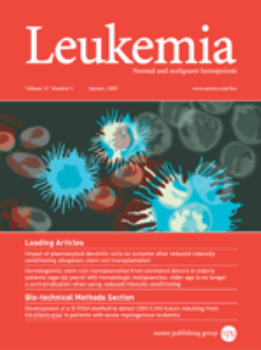YTHDC1 is a therapeutic target for B-cell acute lymphoblastic leukemia by attenuating DNA damage response through the KMT2C-H3K4me1/me3 epigenetic axis
IF 12.8
1区 医学
Q1 HEMATOLOGY
引用次数: 0
Abstract
B-cell acute lymphoblastic leukemia (B-ALL) is an aggressive malignancy characterized by the aberrant accumulation of immature and dysfunctional B cells in bone marrow (BM). Although chemotherapy and other therapies have been widely applied, some patients such as relapsed or drug-refractory (R/R) B-ALL patients exhibit limited response. YT521-B homologous domain-containing protein 1 (YTHDC1) is a nuclear reader of N6-methyladenosine (m6A) RNA modification, which has been implicated in different malignancies including leukemia. In the current study, we show that YTHDC1 is highly expressed in B-ALL cells. YTHDC1 knockdown attenuated B-ALL cell proliferation and cell cycle progression in vitro, and prolonged survival of mice in the human B-ALL xenograft model in vivo attributable to compromised leukemogenesis. Mechanistically, YTHDC1 knockdown significantly increased the accumulation of endogenous and chemotherapeutic agents-induced DNA damage in B-ALL cells. Furthermore, we identified that YTHDC1 binds to and stabilizes m6A-modified KMT2C mRNA. KMT2C is a key enzyme catalyzing histone H3K4 methylation required for the expression of DNA damage response (DDR)-related genes, implying that YTHDC1 inhibitors might improve chemotherapy by attenuating DDR via reducing KMT2C. Indeed, with molecular docking and biochemical experiments, we identified EPZ-5676 as a YTHDC1 inhibitor, and combination of EPZ-5676 with Cytarabine (Ara-c) significantly improved the efficacy of chemotherapy in B-ALL mouse models using YTHDC1high primary and lined B-ALL cells. Collectively, YTHDC1 is required for DDR in B-ALL cells by upregulating DDR-related gene expression via stabilizing m6A-modified KMT2C mRNA, thereby leading to increased histone H3K4 methylation, and targeted inhibition of YTHDC1 is a potentially new therapeutic strategy against B-ALL, especially YTHDC1high B-ALL.


YTHDC1通过KMT2C-H3K4me1/me3表观遗传轴减弱DNA损伤反应,是B细胞急性淋巴细胞白血病的治疗靶点。
B 细胞急性淋巴细胞白血病(B-ALL)是一种侵袭性恶性肿瘤,其特点是骨髓(BM)中未成熟和功能失调的 B 细胞异常聚集。虽然化疗和其他疗法已被广泛应用,但一些患者,如复发或药物难治性(R/R)B-ALL 患者的反应有限。YT521-B同源结构域含蛋白1(YTHDC1)是N6-甲基腺苷(m6A)RNA修饰的核阅读器,与包括白血病在内的不同恶性肿瘤有关。在本研究中,我们发现 YTHDC1 在 B-ALL 细胞中高度表达。体外敲除 YTHDC1 可减轻 B-ALL 细胞的增殖和细胞周期的进展,体内敲除 YTHDC1 可延长人类 B-ALL 异种移植模型小鼠的存活时间,这归因于白血病的发生受到了影响。从机理上讲,YTHDC1 基因敲除会显著增加 B-ALL 细胞中内源性和化疗药物诱导的 DNA 损伤的积累。此外,我们还发现 YTHDC1 与 m6A 修饰的 KMT2C mRNA 结合并使其稳定。KMT2C是催化DNA损伤应答(DDR)相关基因表达所需的组蛋白H3K4甲基化的关键酶,这意味着YTHDC1抑制剂可能会通过减少KMT2C来减弱DDR,从而改善化疗。事实上,通过分子对接和生化实验,我们发现 EPZ-5676 是一种 YTHDC1 抑制剂,而且 EPZ-5676 与阿糖胞苷(Ara-c)联用可显著提高使用 YTHDC1 高的原代和内衬 B-ALL 细胞的 B-ALL 小鼠模型的化疗效果。总之,YTHDC1通过稳定m6A修饰的KMT2C mRNA上调DDR相关基因的表达,从而导致组蛋白H3K4甲基化的增加,是B-ALL细胞DDR所必需的。
本文章由计算机程序翻译,如有差异,请以英文原文为准。
求助全文
约1分钟内获得全文
求助全文
来源期刊

Leukemia
医学-血液学
CiteScore
18.10
自引率
3.50%
发文量
270
审稿时长
3-6 weeks
期刊介绍:
Title: Leukemia
Journal Overview:
Publishes high-quality, peer-reviewed research
Covers all aspects of research and treatment of leukemia and allied diseases
Includes studies of normal hemopoiesis due to comparative relevance
Topics of Interest:
Oncogenes
Growth factors
Stem cells
Leukemia genomics
Cell cycle
Signal transduction
Molecular targets for therapy
And more
Content Types:
Original research articles
Reviews
Letters
Correspondence
Comments elaborating on significant advances and covering topical issues
 求助内容:
求助内容: 应助结果提醒方式:
应助结果提醒方式:


